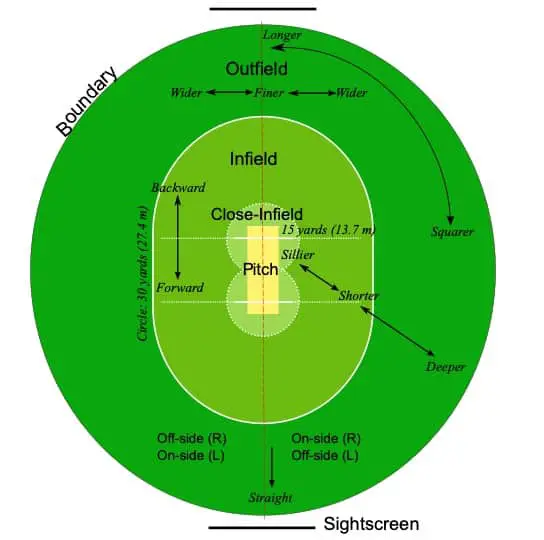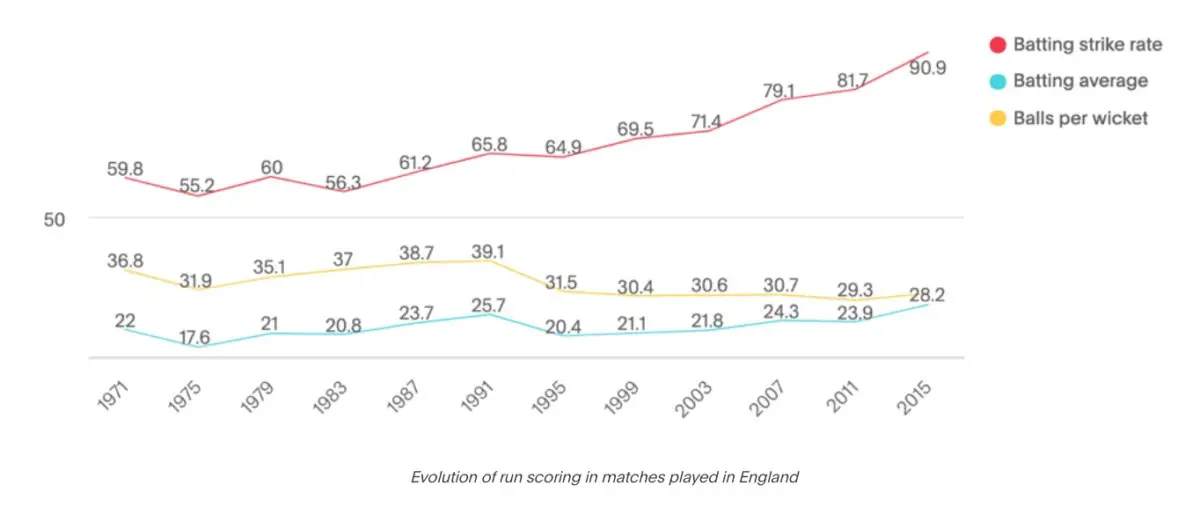The 30-yard circle is often thought to be one of the more confusing aspects of the cricketing rule book. In reality, it’s a very simple but important element of the modern game, that every cricket fan should get to know.
The 30-yard circle in cricket is also known as the inner circle. It’s marked out by two semi-circles at a 30-yard (27m) radius from the middle stumps at each end. These semi-circles are joined by lines running parallel to the wicket and this separated the ‘infield’ and the ‘outfield’.
However, the implications of this divide are where many people start to get confused. This isn’t actually as complicated as it might seem at first glance. Let’s look at it in detail!
Why was the 30-yard Circle Introduced?
For much of the history of the game there was no such thing as 30-yard circle. It was first introduced in Australia in the 1980s, in order to limit the number of fielders who could stand at a distance from the batsmen. These limitations were known as field restrictions.

By forcing the fielding team to leave gaps around the boundary, the rule-makers were encouraging batsmen to hit more fours and sixes. This meant more runs, more mistakes and ultimately, more excitement! The 30-yard circle is one of the major factors in the increasing total runs scored by teams in the shorter forms of the game.
Initially, these limitations on field settings were applied in only the first fifteen overs of an innings – meaning that opening batsmen who might normally try and simply avoid getting out to the opening bowling attack might instead try and get the scoreboard ticking over straight away.
As time has gone on, the number of overs in an innings in which these restrictions are put in place has changed and they have also been given a specific name – the Powerplay.
What is a Powerplay? How is it Associated with the 30-yard Circle?
As of 2008, batting teams were given more choice as to when they were able to make the most of these fielding restrictions. This added a new level of strategic planning for batting outfits. Teams needed to time their powerplays with the right batsmen and bowlers to maximise their chances of hitting boundaries.
Specialised short-form captains who knew how to make the most of these restrictions began to become the norm, and teams who could use them most effectively flourished in the years that followed.
The amount of powerplays in an innings, and their length, depend on the format of the game that is being played.
For example, in T20 (in which teams bat for 20 overs each) there are two powerplays which last for the duration of the innings. In the first six overs the fielding team must have no more than two men stood outside the 30-yard circle when the bowler bowls the ball. While in the following fourteen overs there mustn’t be more than five fielders beyond the circle.
I wrote about the Powerplay in Cricket in detail in another article where I talk about the basic rules, its history and the evolution! Be sure to check it out –
How is the 30-yard Circle used in the ODIs?
In International One Day matches (known as ODIs and where teams bat for 50 overs each) there are compulsory powerplays in the first ten overs of an innings. During this time only two fielders are allowed to be placed in the outfield.
Furthermore, there must be at least three fielders placed on either the off or leg side at any one time during this type of powerplay. This encourages both sides to bat and bowl aggressively in the opening period of the innings.

In the final ten overs of an ODI innings the fielding team must again comply with restrictions as to their field setting. During this section of the innings they must, as of 2015, have more no more than five fielders stood outside the 30-yard circle. This was put into place to encourage batting teams to push for a win, right ‘til the end of the match, even if they are trailing by a long margin prior to the 40th over.
Along with other developments in the game, including more professionalised leagues and greater use of technology in coaching, the use of powerplays in one day cricket has been pivotal in the increased run-rates that have been seen in the years since their introduction. For example, in the 1990s when powerplays first became common-place the average One Day run rate was just over 4 runs an over – whereas it is now almost 6. That’s an increase of almost 50%.
Is the 30-yard Circle used in Test Matches?
However, it must be noted that the 30-yard circle plays little to no role in the longest form of the game. In three- and five-day Test Matches fielding teams are allowed to be placed almost anywhere. The only restriction is that you must not have more than two fielders place behind square on the leg-side. This rule applies to all forms of the game and was designed to prevent bowlers setting fields which encouraged them to bowl at the batsmen’s body as became popular in the Bodyline Ashes Tour of 1932-33.
Is the 30-yard Circle used in Women’s Cricket?
In the women’s game it is also worth mentioning that the circle is smaller than it is in the men’s game. Instead of being 30 yards it is, in fact, five yards shorter. During powerplays in the shorter forms of women’s cricket, there must be no more than two fielders in the outfield. During the rest of the innings there can be no more than five players of the fielding team standing beyond the inner circle.
What happens if You Don’t Comply With the Fielding Restrictions?
You may now be wondering what happens if a team were to fall foul of the restrictions and have too many fielders in the wrong area of the field. It is up to the umpires to keep an eye on this each ball and if they see a team breaking these rules, they must declare the ball a ‘no ball’. This results in the batting side being awarded an extra run, and the bowler must then bowl an extra ball in that over – giving the batsmen yet another chance to get runs.
As such, it’s an important rule for a captain to get their head around and keep an eye on during the game. A failure to do so is a sure-fire way to give away easy runs and make your life more difficult when chasing or defending a score. It’s also important to understand the rule from a spectator’s point of view, as it might explain why the team you are watching are leaving apparently enormous gaps in their field setting.
What is the Close Infield?
While the 30-yard circle should now make sense, there is one last element of the fielding rings that must be taken into consideration and that is the ‘close-infield’. This is another set of circular lines which can sometimes be seen on the cricket field.
The ‘close-infield’ comprises of two semi-circles of 15 meters in diameter and they sit within the 30-yard circle. This is used to delineate where those fielding in close proximity to the batsmen, including slips and those in ‘silly’ positions can be found. There are, thankfully, no specific rules about this and it is more commonly used as a guide when helping captains place their field.
Final Thoughts
You now know everything there is to know about the 30-yard circle on the cricket field and how its introduction played a central role in the development of the modern game. It placed greater importance on the tactics of field placement and has led to many of the games’ highest scores, biggest hits and closest finishes! Do keep an eye out for the 30-yard circle the next time you are watching a game.
